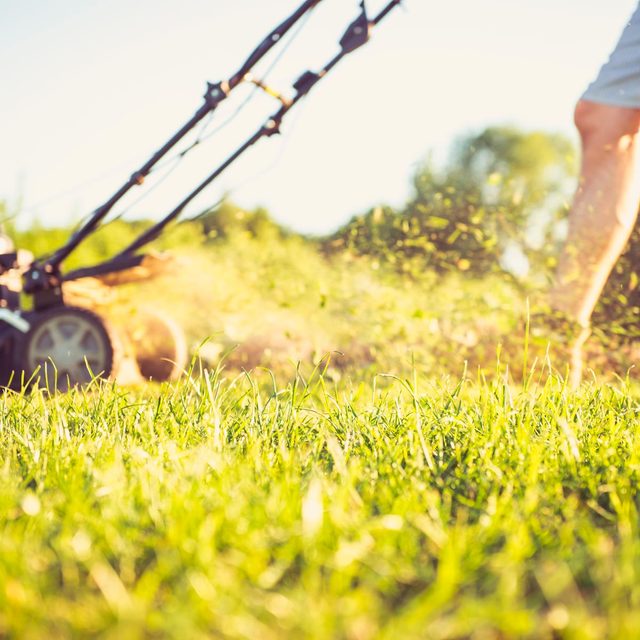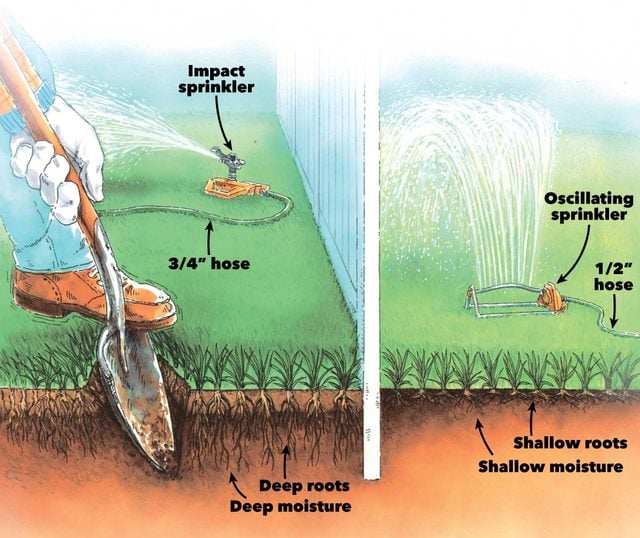Quick Make Your Lawn Great Again

Yous Don't Take to Slave Over Your Lawn to Keep information technology Healthy
If you're an boilerplate homeowner (and of course you're not!), you spend almost four hours a week on yard piece of work and mow your backyard 30 times a yr. And while y'all may non realize it, your lawn pays you dorsum for all this hard work. It serves as a giant air conditioner to assistance cool your dwelling house. It releases a tremendous amount of oxygen and captures tons of dirt and grit to aid keep you and your family healthy. Information technology gives you lot a place to play croquet. (You'll love these 12 lawn games, too!) And the healthier your lawn is, the better information technology keeps upwards its stop of the bargain.
The good news is, you don't have to slave over your lawn to go along information technology healthy. In fact, to a great extent, information technology's not the amount of work you put into your lawn — it'southward when and how you practise it. The following half dozen "ingredients" are essential for a healthy backyard. Nosotros focus on northern or absurd-climate grasses like bluegrass and fescue, merely most of the information applies to warm-climate grasses like zoysia and Bermuda grass, too.
Tip No. 1: Adjust your cutting height to the time of year.
The best tiptop to cutting grass depends on the type of grass, the region and the time of year. For cool-climate grasses, use a 1-one/2 in. cutting height for the showtime mowing of the year to remove expressionless grass and let more sunlight to attain the crowns of the grass plants. Raise the blade during the heat of summer to 2 inches or more. So lower the blade back to one-ane/2 in. for the last cutting of the twelvemonth. For warm-climate grasses, these heights will be nearly 1/2 in. lower.
When adjusting your blade top, measure from a hard surface to the bottom of the mower deck, then add 1/4 in. Well-nigh blades sit 1/4 in. above the bottom of the deck.

Tip No. 2: Use a Sharp Mower Blade
A well-maintained, precipitous and counterbalanced blade cuts grass cleanly and evenly (see above). A slow one tears grass instead of cutting it cleanly. Damaged grass turns yellowish, requires more than water and nutrients to recover, and is more susceptible to disease. An unbalanced bract compounds the problem and can damage your lawn mower's bearings. Sharpening and balancing a blade three times a year is commonly plenty to maintain a proficient cutting edge — unless you hit lots of rocks. Here'due south how to sharpen a lawn mower blade.

Tip No. three: A few expert soakings are better than lots of calorie-free sprinklings
Deep watering helps develop deep roots that tap into subsurface water supplies (illustration below). Light sprinklings moisten only the grass and surface of the soil, encouraging shallow root growth and increasing the need for more frequent watering. Lawns generally require 1 to 2 in. of water per week from yous or Mother Nature, applied at 3- or four-solar day intervals. Merely this varies drastically depending on the temperature, type of grass and soil conditions. Lawns in sandy soils may need twice equally much water since they bleed chop-chop. Lawns in slow-draining clay soils may need but one-half as much.
When your backyard loses its bounce or resiliency, or when it wilts, exposing the slow green bottoms of the blades, it needs water. In general, water until the soil is moist four to five inches downwards, then wait to water again until the top ane or two inches dries out. To find out how much water your sprinkler delivers, ready out a block pan, plow on your sprinkler, then time how long information technology takes for the water to attain a depth of one inch (see above).
The best time of twenty-four hour period to water is early morning. Water force per unit area is high, less water is lost to evaporation and your backyard has plenty of time to dry before nightfall. Lawns that remain moisture overnight are more than susceptible to illness caused by wet-loving mold and other fungi.
Properly watered lawns develop deep, salubrious roots. An bear on sprinkler delivers water quickly, with less "hang time" for evaporation; a 3/four-in. hose delivers much more h2o volume than its 1/2-in. cousin.
Improperly watered lawns receive brusque daily waterings that promote shallow root growth. Oscillating sprinklers toss water in a high arc, so more evaporates before reaching the soil. Water your lawn meliorate with these 10 like shooting fish in a barrel tips.

Tip No. 4: Mow only the top 1-third of the grass blade (and don't rake upward the clippings)
The top ane-third of a blade of grass is sparse and "leafy," decomposes apace when cut and can contribute up to i-3rd of the nitrogen your lawn needs (illustration below). While it'south decomposing, this lite layer of clippings also helps tiresome water evaporation and keeps weeds from germinating. Check out these handy mowing tips.
But the bottom two-thirds of a blade of grass is tough, "stemmy" and slow to decompose, contributing to thatch. When thick plenty, thatch prevents sunlight, air, water and nutrients from reaching the soil. Cutting more than than the top third too shocks grass roots and exposes stems, which tend to burn in direct sunlight.
Then if two inches is your target grass superlative, cut it when it reaches three inches. Since grass grows at unlike rates at different times of the year, "every Saturday" isn't necessarily the best fourth dimension to mow. Sometimes y'all need to mow it more, other times less. The ideal length for cool-climate grasses is 3 to iv inches; for warm-climate, one to two inches.
Mow when the grass is dry and avoid mowing in the heat of the twenty-four hours when you're more probable to stress the grass — and yourself.
Check out a video that explains more on why mowing at the correct height is so important.

Tip No. 5: With fertilizers and weed killers, timing is everything
When applying weed killers and fertilizers, take into account variables like geographic location, grass type, weed blazon and soil atmospheric condition. Here are a few general guidelines:
- A thick, healthy backyard (illustration beneath) that doesn't provide weed seeds adequate sunlight or open space to germinate is your best defense against weeds. A sick, spotty backyard leaves lots of open infinite for weeds to take root and abound.
- Attack weeds in the early spring and summer before they take a gamble to develop deep root systems, get to seed or reproduce.
- Dissimilar weeds require dissimilar chemicals and methods. It'south best to eradicate grassy weeds like crabgrass with pre-emergent weed killers, which destroy germinating plants every bit they sprout. Broadleaf weeds need to be attacked while they're immature and actively growing; spraying the leaves of individual plants or patches of plants is most effective. Dandelion killers work by literally growing the institute to decease.
- Fertilize in early on spring to spring-start root development. Fall feedings help repair summer damage and spur the root growth that goes on for several weeks fifty-fifty after the top growth stops, helping grass survive the winter. Low-cal feedings in between help maintain healthy growth.
- Read the parcel. Some chemicals piece of work only in the presence of moisture; other chemicals are rendered useless by water. Heed the safety warnings besides.
The best resources for identifying and troubleshooting weeds is a plant nursery or garden centre familiar with local weather.

Tip No. 6: Aerate your lawn to assistance it 'breathe'
Grass roots need oxygen as well as water and nutrients. Aerating — the process of removing small plugs of soil (see illustration) — produces multiple benefits. It improves air-to-soil interaction. It allows water and fertilizer to penetrate the soil deeper and easier. It reduces soil compaction and opens space for roots to grow. It removes some thatch and stimulates the breakdown of the remaining thatch. The best tool for this task is a gas-powered aerator, available at most rental centers.
[Related: Have y'all ever considered trying backyard aerator shoes? Detect out if they really piece of work here.]
Again, timing is critical. You lot can aerate in the leap. But fall, afterwards the kids are through trampling the grass and there are fewer weed seeds to gear up abode in the open spaces, is the optimal fourth dimension to aerate. It's usually best to aerate start, so apply whatever weed killers and so the open holes are protected confronting weeds.

A well-aerated lawn provides space for grass roots to grow, reproduce and take in more oxygen, moisture and nutrients. The plugs, composed of thatch and soil, apace break apart and decompose. The roots of a compacted lawn take difficulty absorbing air, h2o and nutrients.

What'southward next? Landscaping
At present that you have a beautiful lawn, check out these tips for landscaping your backyard.
fisheranciverivens.blogspot.com
Source: https://www.familyhandyman.com/article/how-to-achieve-a-healthy-lawn/
0 Response to "Quick Make Your Lawn Great Again"
Postar um comentário